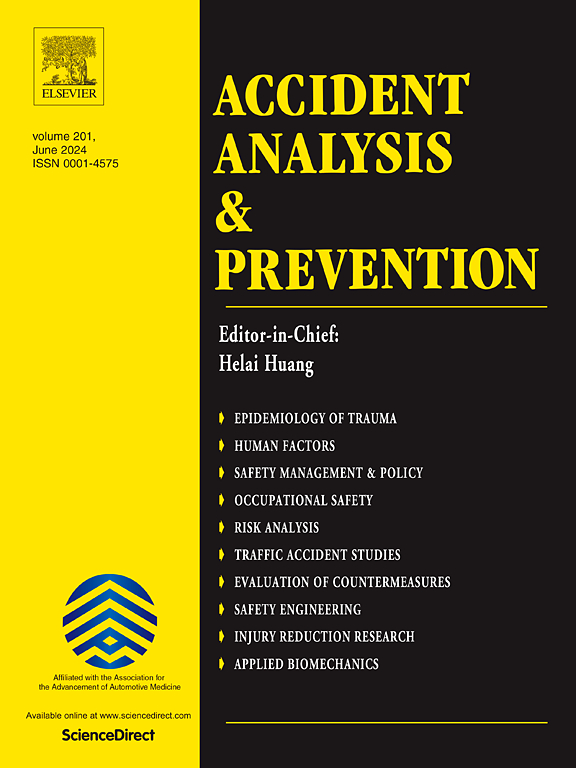Strategic naps in automated driving − Sleep architecture predicts sleep inertia better than nap duration
IF 6.2
1区 工程技术
Q1 ERGONOMICS
引用次数: 0
Abstract
At higher levels of driving automation, drivers can nap during parts of the trip but must take over control in others. Awakening from a nap is marked by sleep inertia which is tackled by the NASA nap paradigm in aviation: Strategic on-flight naps are restricted to 40 min to avoid deep sleep and therefore sleep inertia. For future automated driving, there are currently no such strategies for addressing sleep inertia. Given the disparate requirements, it is uncertain whether the strategies derived from aviation can be readily applied to automated driving. Therefore, our study aimed to compare the effects of restricting the duration of nap opportunities following the NASA nap paradigm to the effects of sleep architecture on sleep inertia in takeover scenarios in automated driving.
In our driving simulator study, 24 participants were invited to sleep during three automated drives. They were awakened after 20, 40, or 60 min and asked to manually complete an urban drive. We assessed how napping duration, last sleep stage before takeover, and varying proportions of light, stable, and deep sleep influenced self-reported sleepiness, takeover times, and the number of driving errors.
Takeover times increased with nap duration, but sleepiness and driving errors did not. Instead, all measures were significantly influenced by sleep architecture. Sleepiness increased after awakening from light and stable sleep, and takeover times after awakening from light sleep. Takeover times also increased with higher proportions of stable sleep. The number of driving errors was significantly increased with the proportion of deep sleep and after awakenings from stable and deep sleep.
These results suggest that sleep architecture, not nap duration, is crucial for predicting sleep inertia. Therefore, the NASA nap paradigm is not suitable for driving contexts. Future driver monitoring systems should assess the sleep architecture to predict and prevent sleep inertia.
自动驾驶中的策略性小睡--睡眠结构比小睡时间更能预测睡眠惰性。
在更高水平的自动驾驶中,驾驶员可以在部分行程中打盹,但在其他行程中必须接管控制权。小睡后醒来会出现睡眠惰性,美国国家航空航天局(NASA)在航空领域采用的小睡范式可解决这一问题:飞行中的战略性小睡时间限制在 40 分钟以内,以避免深度睡眠和睡眠惰性。对于未来的自动驾驶,目前还没有解决睡眠惰性的策略。鉴于要求不同,目前还不能确定从航空业中得出的策略是否能随时应用于自动驾驶。因此,我们的研究旨在比较按照美国宇航局的小睡范例限制小睡机会的持续时间与睡眠结构对自动驾驶中接管情景下睡眠惰性的影响。在我们的驾驶模拟器研究中,24 名参与者被邀请在三次自动驾驶过程中睡觉。他们在 20、40 或 60 分钟后被唤醒,并被要求手动完成一次城市驾驶。我们评估了小睡持续时间、接管前的最后一个睡眠阶段以及浅睡眠、稳定睡眠和深睡眠的不同比例对自我报告的嗜睡程度、接管时间和驾驶错误次数的影响。接管时间随着午睡时间的延长而增加,但嗜睡和驾驶失误却没有增加。相反,所有测量指标都受到睡眠结构的显著影响。从浅睡眠和稳定睡眠中醒来后,嗜睡感会增加,从浅睡眠中醒来后,接管时间也会增加。稳定睡眠比例越高,接管时间也越长。随着深度睡眠比例的增加,以及从稳定睡眠和深度睡眠中醒来后,驾驶失误的次数也会明显增加。这些结果表明,预测睡眠惰性的关键是睡眠结构,而不是午睡时间。因此,美国国家航空航天局的小睡模式并不适合驾驶环境。未来的驾驶员监测系统应评估睡眠结构,以预测和预防睡眠惰性。
本文章由计算机程序翻译,如有差异,请以英文原文为准。
求助全文
约1分钟内获得全文
求助全文
来源期刊

Accident; analysis and prevention
Multiple-
CiteScore
11.90
自引率
16.90%
发文量
264
审稿时长
48 days
期刊介绍:
Accident Analysis & Prevention provides wide coverage of the general areas relating to accidental injury and damage, including the pre-injury and immediate post-injury phases. Published papers deal with medical, legal, economic, educational, behavioral, theoretical or empirical aspects of transportation accidents, as well as with accidents at other sites. Selected topics within the scope of the Journal may include: studies of human, environmental and vehicular factors influencing the occurrence, type and severity of accidents and injury; the design, implementation and evaluation of countermeasures; biomechanics of impact and human tolerance limits to injury; modelling and statistical analysis of accident data; policy, planning and decision-making in safety.
 求助内容:
求助内容: 应助结果提醒方式:
应助结果提醒方式:


